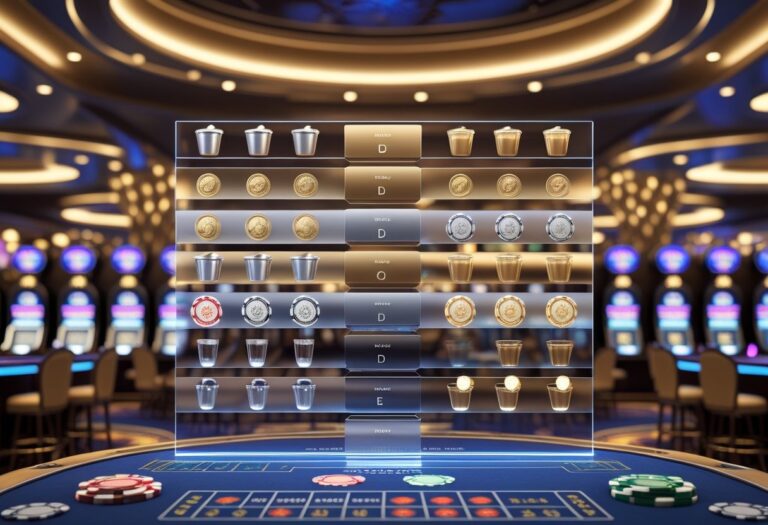
A Comprehensive Guide to Craps Strategy: Maximizing Your Casino Odds
Craps stands as one of the most mathematically advantageous casino games, offering strategic players exceptional opportunities for success. While the dynamic table layout and energetic atmosphere might appear overwhelming, understanding core craps fundamentals transforms hesitant observers into confident participants.
Understanding the Basic Odds
The mathematical foundation of craps centers on probability distributions and house edge calculations. The Pass Line bet, a fundamental starting point, carries a mere 1.41% house edge, making it one of the most favorable wagers in casino gaming. When combined with optimal odds betting strategies, players can effectively minimize the statistical disadvantage.
Essential Craps Betting Strategies
Strategic betting patterns in craps require:
- Mastering Pass Line and Come bets
- Understanding optimal odds placement
- Recognizing favorable betting combinations
- Managing bankroll through systematic progression
Advanced Table Tactics
Experienced players leverage advanced craps techniques by:
- Capitalizing on hot streaks
- Implementing controlled betting progression
- Recognizing optimal table conditions
- Utilizing mathematical probability models
Frequently Asked Questions
Q: What is the safest bet in craps?
A: The Pass Line bet offers the lowest house edge combined with simple odds.
Q: How much bankroll is recommended for craps?
A: A minimum of 50 times your average bet ensures adequate playing time and proper bankroll management.
Q: What are the best odds in craps?
A: The odds bet behind Pass Line offers true odds with zero house edge.
Q: Should beginners stick to basic bets?
A: Yes, mastering Pass Line and Come bets builds fundamental understanding before advancing to complex strategies.
Q: How important is bankroll management in craps?
A: Critical – proper bankroll management prevents premature losses and enables strategic long-term play.
The Basics of Craps

The Ultimate Guide to Playing Craps: Rules, Strategy & Betting
Understanding Basic Craps Gameplay
Craps stands as one of the most dynamic casino table games, featuring multiple betting options and distinctive terminology.
While the table layout may initially appear complex, mastering the fundamental rules enables players to participate confidently in this classic dice game.
Core Game Mechanics
The game revolves around a designated shooter rolling two dice, with participants betting on various potential outcomes.
The initial throw, known as the come-out roll, determines the game’s direction:
- Natural Winners: Rolling a 7 or 11 results in immediate victory
- Craps Numbers: Rolling 2, 3, or 12 leads to an instant loss
- Point Numbers: Rolling 4, 5, 6, 8, 9, or 10 establishes the point
Point Phase Gameplay
Once a point number is established, the shooter continues rolling until either:
- The point number appears again (winning outcome)
- A 7 is rolled (losing outcome)
Essential Betting Options
Pass Line Betting
The Pass Line bet represents the most fundamental wager in craps:
- Wins on come-out rolls of 7 or 11
- Loses on come-out rolls of 2, 3, or 12
- Continues through point phase until resolution
Don’t Pass Betting
The Don’t Pass bet operates inversely to the Pass Line:
- Wins on come-out rolls of 2 or 3
- Ties on 12
- Wins if 7 appears before point number
Frequently Asked Questions
Q: What’re the best odds in craps?
A: The Pass Line bet offers among the lowest house edges at 1.41%
Q: Can multiple players roll the dice?
A: Yes, the shooter position rotates clockwise around the table
Q: Is there a minimum bet requirement?
A: Each casino establishes its own minimum bet requirements
Q: How long does a typical craps game last?
A: Individual rounds can range from seconds to several minutes
Q: What’s the optimal strategy for beginners?
A: Start with Pass Line bets and gradually learn additional betting options
Essential Table Layout Guide

Essential Craps Table Layout Guide
Understanding the Basic Layout
The craps table features a sophisticated layout designed for optimal gameplay efficiency.
The table’s structure comprises distinct betting zones that accommodate multiple players simultaneously. I’ll detail each section to help you navigate the gaming surface with confidence.
Center Section
The proposition betting area occupies the central portion, featuring high-payout wagers including:
- Any Seven combinations
- Hard Ways bets
- Single-roll proposition wagers
- Multiple craps numbers
Outer Sections
Mirrored betting areas span both sides of the table, ensuring accessibility for all players. Key elements include:
- Pass Line positioned along the outer edge
- Don’t Pass Bar located directly above
- Come and Don’t Come zones
- Place bet boxes for numbers 4, 5, 6, 8, 9, and 10
Field Section
The Field betting area prominently displays:
- Numbers 2 and 12
- Numbers 3 and 11
- Numbers 4, 9, and 10
Table Personnel Zone
Strategic positioning of casino staff includes:
- Boxperson stationed at center position
- Two dealers operating from opposing sides
- Chip storage aprons at table ends
Frequently Asked Questions
Q: What’s the most important betting area on a craps table?
A: The Pass Line represents the fundamental betting area, offering the best odds and lowest house edge.
Q: How are proposition bets different from regular bets?
A: Proposition bets in the center section typically offer higher payouts but carry a larger house edge and resolve in a single roll.
Q: Why does the table have mirrored sections?
A: The mirrored layout ensures all players can easily access betting areas regardless of their position at the table.
Q: What purpose do the aprons serve?
A: Table aprons provide designated areas for players to store and organize their chips during gameplay.
Q: Where should beginners focus their attention on the layout?
A: Beginners should concentrate on the Pass Line and Come areas, as these offer the most straightforward bets with favorable odds.
Understanding Pass Line Bets

Understanding Pass Line Bets in Craps: The Essential Guide
The Fundamentals of Pass Line Betting
The Pass Line bet stands as the cornerstone of successful craps strategy, representing the most fundamental and statistically advantageous wager available.
This essential betting option provides players with a remarkably low house edge of just 1.41%, making it a prime choice for both novices and experienced players.
How Pass Line Bets Work
The Come-Out Roll Phase
During the initial phase, known as the come-out roll, players win immediately when the shooter rolls a natural (7 or 11). Conversely, rolling craps numbers (2, 3, or 12) results in an instant loss. Any other number (4, 5, 6, 8, 9, or 10) establishes the point number.
The Point Phase
Once a point is established, the game transitions to its second phase. The objective shifts to rolling the point number again before a 7 appears. A successful point roll results in a win, while rolling a seven 먹튀검증커뮤니티 out leads to a loss.
Frequently Asked Questions
Q: What makes Pass Line bets advantageous?
A: Pass Line bets offer one of the lowest house edges in craps at 1.41%, providing favorable odds for players.
Q: Can I place Pass Line bets after the come-out roll?
A: No, Pass Line bets must be placed before the come-out roll begins.
Q: What happens if a point is established?
A: The shooter continues rolling until either the point number repeats (win) or a 7 appears (loss).
Q: Are Pass Line bets mandatory?
A: While Pass Line bets are standard, they’re not mandatory. Players can choose alternative betting options.
Q: Can I remove a Pass Line bet once placed?
A: Pass Line bets can’t be removed or reduced after the point is established.
Come Bets and Field Bets

Understanding Come Bets and Field Bets in Craps
Come Bets: Advanced Pass Line Strategy
Come bets represent a sophisticated betting option that mirrors the Pass Line bet mechanics while offering additional opportunities during gameplay.
Players can place these bets after the establishment of a point, effectively creating a personal come-out roll on the next throw.
Winning Come bet scenarios occur when:
- The initial roll results in a 7 or 11
- The established Come point number appears before a 7
Losing Come bet conditions include:
- Rolling a 2, 3, or 12 on the Come-out roll
- A 7 appears before the Come point number
Field Bets: Single-Roll Action
Field bets offer immediate results through single-roll wagers covering seven specific numbers: 2, 3, 4, 9, 10, 11, and 12. These bets feature enhanced payouts on certain numbers:
Standard Field bet payouts:
- 2x payout for rolling 2 or 12
- Some establishments offer 3x payout on 12
- Even money payout for 3, 4, 9, 10, and 11
#
Frequently Asked Questions
Q: What happens to Come bets when a 7 is rolled?
A: Come bets lose if a 7 appears before the established Come point number.
Q: Can multiple Come bets be placed simultaneously?
A: Yes, players can maintain multiple Come bets on different numbers.
Q: Are Field bets more volatile than Come bets?
A: Yes, Field bets offer higher volatility due to their single-roll nature.
Q: Which numbers lose on Field bets?
A: Numbers 5, 6, 7, and 8 result in Field bet losses.
Q: Do Field bets remain active for multiple rolls?
A: No, Field bets are resolved on the immediate next roll.
Playing the Odds Strategy

Mastering the Odds Strategy in Craps
Understanding the Power of Odds Bets
The Odds bet represents the most mathematically favorable wager in casino craps, offering players a unique opportunity with zero house edge.
This strategic betting option stands apart from conventional Come and Field bets, providing exceptional value for informed players.
Maximizing Odds Bet Potential
To implement the optimal Odds strategy, players must first place a Pass Line bet.
Once the point is established, they can enhance their position by placing an Odds bet behind their original wager.
Casinos typically permit multiple odds ranging from 1x to 100x the initial bet, varying by establishment.
Odds Bet Payouts and Structure
The payout structure for Odds bets follows true probability:
- 4 and 10: Pays 2:1
- 5 and 9: Pays 3:2
- 6 and 8: Pays 6:5
Strategic Implementation
Taking maximum odds whenever bankroll permits represents the strongest approach to minimize the house advantage.
This advanced betting method requires proper timing, as Odds bets can only be placed after point establishment and can’t stand alone.
FAQ: Craps Odds Strategy
Q: What makes Odds bets superior to other craps wagers?
A: Odds bets offer true odds with no house edge, making them mathematically superior to all other casino bets.
Q: When can I place an Odds bet?
A: Odds bets can only be placed after establishing a point on Pass Line bets.
Q: What’s the maximum Odds bet allowed?
A: Maximum odds vary by casino, typically ranging from 1x to 100x the original bet.
Q: Are Odds bets available on all craps tables?
A: Yes, all traditional craps tables offer Odds bets, though maximum limits vary.
Q: How do Odds bets affect overall house edge?
A: Taking maximum Odds significantly reduces the overall house edge on Pass Line bets.
Smartest Bets at Craps

The Smartest Bets in Craps: Maximizing Your Odds of Winning
Understanding the Best Craps Betting Strategies
In craps, strategic betting can significantly improve your chances of success.
The three most mathematically advantageous bets are the Pass Line with odds, Come bet with odds, and Don’t Pass with odds. These wagers consistently deliver the strongest probability of winning while maintaining minimal house edge.
Pass Line Bet: The Foundation of Smart Craps Play
The Pass Line bet stands as the cornerstone of intelligent craps strategy, featuring a modest 1.41% house edge.
By supplementing this wager with odds bets, players can effectively reduce the overall house advantage. This fundamental betting option provides optimal mathematical value while aligning with the natural flow of the game.
Come Bet Strategy: Expanding Your Opportunities
The Come bet mirrors the Pass Line’s favorable odds structure while offering additional betting positions after point establishment.
This versatile option enables players to maintain multiple active wagers simultaneously, each benefiting from the same advantageous house edge of 1.41%.
Don’t Pass Betting: The Contrarian Advantage
For players willing to bet against the shooter, the Don’t Pass bet presents an even more favorable 1.36% house edge. While less popular among social players, this mathematically superior option consistently delivers better long-term results.
Bets to Avoid
Proposition bets and Big 6/Big 8 wagers carry substantial house edges exceeding 9%, making them significantly less favorable for strategic players. These high-risk options should be avoided in favor of more mathematically sound betting choices.
#
Frequently Asked Questions
Q: What’s the single best bet in craps?
A: The Don’t Pass bet with odds offers the lowest house edge at 1.36%.
Q: How do odds bets improve my chances?
A: Odds bets carry no house edge, effectively reducing the overall house advantage on your primary bet.
Q: Are proposition bets ever worth making?
A: Proposition bets typically carry house edges over 9%, making them mathematically unfavorable.
Q: Can I combine multiple smart bets?
A: Yes, players can effectively combine Pass Line and Come bets to maintain multiple advantageous positions.
Q: What’s the minimum bankroll for smart craps betting?
A: A bankroll of at least 20 times your base bet allows for proper odds betting and sustainable play.
Money Management Tips

Essential Money Management Strategies for Casino Success
Setting Your Gambling Budget
Proper bankroll management is fundamental to successful gambling outcomes.
Before approaching any gaming table, establish a concrete budget that represents disposable income you can afford to lose.
Leave credit cards and ATM cards at home to prevent impulsive spending beyond predetermined limits.
Strategic Bankroll Protection
Setting Win-Loss Parameters
- Win Goal: Target 50% profit on initial investment
- Loss Limit: Cap losses at 50-60% of total bankroll
- Track Progress: Monitor wins/losses systematically
Three-Stack System
Implement a proven chip management system:
- Betting Stack: Active wagering funds
- Winnings Stack: Accumulated profits
- Original Stake: Protected initial investment
Maintaining Discipline
Consistent bet sizing remains crucial for long-term success.
Never escalate wagers to recover losses?�this common pitfall leads to depleted bankrolls.
Exit the game when reaching predetermined loss limits.
Frequently Asked Questions
Q: What’s the ideal bankroll size for a gaming session?
A: Bring 20-30 times your average bet size for adequate playing time.
Q: How often should I adjust my betting amounts?
A: Maintain consistent bet sizes throughout your session unless your bankroll substantially increases.
Q: When is the best time to walk away with winnings?
A: Exit after reaching your preset win goal or when ahead by 50% of your initial bankroll.
Q: Should I ever borrow money to continue playing?
A: Never borrow money or use credit for gambling activities.
Q: How can I track my gambling expenses effectively?
A: Maintain a dedicated gambling ledger recording all sessions, including buy-ins, wins, and losses.
Common Questions
##
Why Do Players Blow on Dice Before Rolling Them?
# Why Do Players Blow on Dice Before Rolling Them?
The practice of blowing on dice before rolling them stems from a deeply ingrained gambling tradition that dates back centuries. This ritualistic behavior combines elements of superstition, psychology, and cultural significance in gaming communities worldwide.
Historical Origins and Cultural Significance
The tradition of blowing for luck originated in ancient civilizations where gamblers believed their breath carried spiritual energy. In many cultures, breath symbolizes life force and divine connection, making it a natural element in gaming rituals.
Psychological Benefits
Dice blowing rituals serve multiple psychological functions:
- Create a sense of control over random outcomes
- Build confidence in the roller
- Establish a consistent pre-roll routine
- Reduce anxiety during high-stakes games
Scientific Perspective
While blowing on dice has no mathematical impact on the outcome, research suggests that pre-game rituals can enhance performance through:
- Improved focus
- Increased confidence
- Reduced stress levels
- Enhanced mind-body connection
Common Questions About Dice Rolling
Q: Does blowing on dice affect the outcome?
No, the physical act of blowing cannot influence the mathematical probability of dice rolls.
Q: Why do casino players blow on dice?
Players blow on dice as a good luck ritual and to maintain traditional gambling customs.
Q: Is dice blowing allowed in casinos?
Most casinos permit this practice, though some may have specific rules about dice handling.
Q: What other dice superstitions exist?
Common beliefs include calling out numbers, specific throwing techniques, and using lucky dice sets.
Q: Do professional gamblers blow on dice?
Many professionals maintain this tradition, viewing it as part of the gaming experience rather than a luck-changing action.
Modern Gaming Culture
Today, dice blowing persists in both casual and professional gaming environments, representing a bridge between traditional gambling culture and contemporary gaming practices. While recognized as superstition, it remains an integral part of the dice rolling experience.
What Happens if the Dice Leave the Craps Table During a Roll?
What Happens When Dice Leave the Craps Table During a Roll?
When dice leave the craps table during a roll, specific protocols must be followed to maintain game integrity. The boxman will immediately call “no roll” and initiate a mandatory inspection process. The shooter must display open palms while the boxman thoroughly examines the original dice for any damage or tampering.
Standard Casino Protocol for Off-Table Dice
Fresh dice will be introduced to the game after dice leave the playing surface. This standard procedure ensures:
- Game integrity remains intact
- No dice tampering occurs
- Fair play continues uninterrupted
- Player confidence is maintained
Inspection Requirements
The boxman’s inspection process includes:
- Verifying dice dimensions
- Checking for visible damage
- Ensuring proper weight distribution
- Confirming authentic casino markings
## Frequently Asked Questions
Q: Are previous bets valid if dice leave the table?
A: No, all bets remain in place until the next valid roll with new dice.
Q: Can players request to continue using the original dice?
A: No, casino protocol requires fresh dice after any off-table incident.
Q: Does leaving the table void the shooter’s turn?
A: No, the same shooter continues with new dice.
Q: What happens if dice hit a player before leaving the table?
A: The boxman will still declare “no roll” and follow standard inspection procedures.
Q: Is there a penalty for repeatedly throwing dice off the table?
A: Frequent occurrences may result in the player losing shooting privileges.
##
Can Players Use Their Own Personal Dice at Casino Craps Tables?
# Can Players Use Their Own Personal Dice at Casino Craps Tables?
In casino craps games, players are strictly prohibited from using personal dice. Casinos exclusively use specially manufactured precision dice that meet rigorous gaming commission standards and incorporate multiple security features to maintain game integrity.
Casino Dice Security Features
These regulation casino dice typically include:
- Transparent materials allowing visible inspection
- Sharp, machined edges for true random rolls
- Perfectly balanced weight distribution
- Serial numbers for authentication
- Specialized logos or casino branding
- Microprinting and other tamper-evident features
Why Personal Dice Are Banned
The ban on personal dice serves several critical purposes:
- Prevents loaded or weighted dice
- Maintains fair gameplay standards
- Ensures regulatory compliance
- Protects casino operations
- Guarantees consistent rolling conditions
## Frequently Asked Questions
Q: Are casino dice different from regular dice?
A: Yes, casino dice are precision-manufactured with exact measurements and special security features not found in standard dice.
Q: How often do casinos change their dice?
A: Casinos typically replace dice every 8 hours or sooner if signs of wear appear.
Q: Can players inspect the casino dice?
A: Yes, players may visually inspect the dice but cannot handle them outside of actual gameplay.
Q: What happens if personal dice are used?
A: Using personal dice is considered cheating and can result in immediate removal, banned entry, and potential legal consequences.
Q: Are electronic dice games different?
A: Electronic craps games use random number generators instead of physical dice, eliminating dice-related security concerns.
How Many Dealers Typically Work at a Single Craps Table?
Craps Table Dealer Staffing: A Complete Guide
Standard Craps Table Staff Configuration
A typical casino craps table operates with 4 dedicated staff members:
- 1 boxperson who supervises the game and manages payouts
- 3 base dealers positioned strategically around the table layout
Dealer Roles and Responsibilities
Boxperson
- Maintains game integrity
- Supervises chip transactions
- Verifies payouts
- Resolves disputes
- Oversees proper dice handling
Base Dealers
- Handle specific betting areas
- Process player wagers
- Pay winning bets
- Clear losing bets
- Assist players with bet placement
Peak Hours and Staffing Variations
During high-volume periods, casinos may adjust staffing:
- Busy weekends: Full 4-person crew
- Slower periods: Reduced to 3 staff members
- Major events: Additional supervisory staff
Q&A Section
How many dealers work at a craps table?
A standard craps table operates with 4 staff members: 1 boxperson and 3 base dealers.
Frequently Asked Questions
1. Can a craps table operate with fewer dealers?
Yes, during slower periods, tables may run with 3 staff members.
2. What is the boxperson’s primary role?
The boxperson supervises the game, verifies payouts, and maintains game integrity.
3. Do all casinos use the same dealer configuration?
Most major casinos follow the standard 4-person configuration, though smaller venues may vary.
4. Are dealers trained for specific positions?
Yes, dealers receive specialized training for their specific roles at the craps table.
5. How do dealers rotate positions?
Dealers typically rotate positions every 20-40 minutes to maintain alertness and fairness.
Are Electronic Craps Machines as Random as Traditional Dice Games?
Electronic Craps vs Traditional Dice: A Randomness Analysis
Electronic craps machines employ certified random number generators (RNGs) that are specifically designed to replicate the exact probability distribution and odds found in traditional dice games. Through rigorous testing and regulatory oversight, these digital systems demonstrate statistical randomness that closely mirrors physical dice rolls.
Technical Implementation
The RNG systems in electronic craps utilize sophisticated algorithms that generate number sequences with the same 1/36 probability for each possible dice combination. These systems undergo regular certification testing by independent laboratories to verify their:
- Statistical randomness
- Fair distribution of outcomes
- Resistance to manipulation
- Compliance with gaming regulations
Comparative Analysis
When examining traditional vs electronic craps, several key factors ensure equivalent randomness:
- Both systems produce results based on 36 possible combinations
- Electronic RNGs eliminate physical variables that might affect dice rolls
- Digital systems prevent dealer influence or mechanical wear
FAQ Section
Q: Are electronic craps machines truly random?
A: Yes, electronic craps machines use certified RNG systems that provide verifiable random outcomes matching physical dice probability.
Common Questions:



